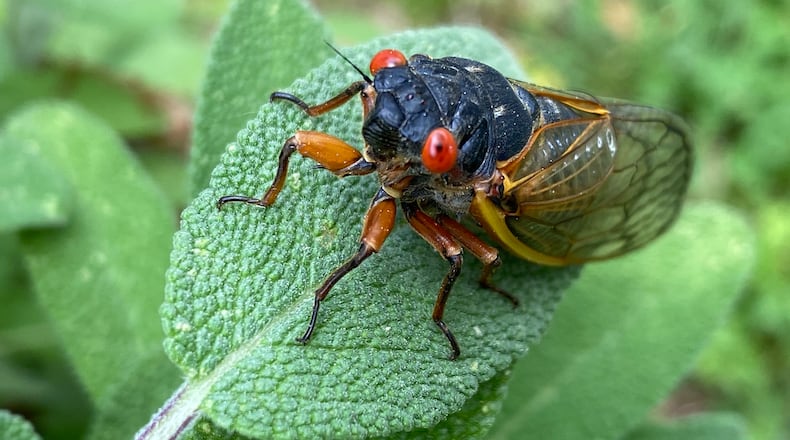While cicadas provide familiar summer background noise in Southwest Ohio, the periodical cicadas go beyond the term “just.” It’s amazing. Flash forward a couple of decades and I was reminded of the fact that this doesn’t happen everywhere. A French colleague was visiting our headquarters in Cincinnati during brood XVI’s last arrival and was amazed. There is a lot to take in.
Annual cicadas live all over the world, are up to 1 ¾ inches, have greenish-black bodies, green eyes, and translucent wings. They show up every year with the heat of summer and blend into the fabric of their surroundings, especially if you’re accustomed to them.
Periodical cicadas only live in eastern North America. They’re called periodical because their lifecycle involves either 13 or 17 years in a nymph stage underground. They are smaller, between ¾ and 1 ¼ inches, have dark bodies, orange veined wings, and red beedy eyes. They don’t blend into anything and can’t be ignored if you’re outside - their numbers and noise won’t allow it.
There are fifteen recognized broods identified with Roman numerals, that follow this pattern, with four appearing in Ohio. Brood XVI (14) is set to complete its 17-year life cycle through several Southwest Ohio counties, including Hamilton, Clermont, Brown, Adams, Gallia, Butler, Warren, Clinton, Highland, Ross, and Greene
Why so loud?
The sounds during a periodical brood’s emergence have been described as deafening. I wouldn’t go that far, but in some locations it can be really loud. The sheer number of cicadas help to increase the volume, but it’s more than that. They’re built for this.
Male cicadas call to attract a mate. Because they have just a few weeks to accomplish the task. They use specialized structures called tymbals on their abdomen. High-speed cameras have revealed that they buckle in sequence to create their unique noise. Hot weather (to a point) has seemed to increase their efficiency and produce more sound. Another component theory to the unique noise is that they’re resonating in two different frequency bands. On top of that, it also happens in ¾ or waltz time. There’s a lot going on, and it is loud. But it only lasts a couple of weeks.
Local impact
The good news is that they don’t bite or carry diseases. They do fly from tree to tree, or as much as an insect that has been underground for 17 years can identify a tree. That means posts, poles, and upright humans could be in the mix. The females can eat some leaves on trees and make it appear bare, it typically doesn’t harm the tree.
They can provide ample food for many species, from wild turkeys and their poults to bass and other fish. That can be great news for young turkey survival. Maybe great news for anglers throwing topwater lures like a crazy crawler, unless the fish have eaten their fill.
Long-time fascination
Thankfully, people have been noting and recording nature forever. It’s played an important role in our understanding of the world around us. Thomas Jefferson noted in his “Garden Book” the arrival of the 17-year periodical Brood II at Monticello in 1775, and that an acquaintance recalled previous “great locust years” in 1724 and 1741, as cicadas were often called.
You can participate and contribute to the understanding of this remarkable event by downloading the Cicada Safari citizen science app. You use it to report sightings and contribute to our understanding of these fascinating creatures.
Devin Meister is a local outdoors and wildlife enthusiast and has a blog called “Average Guy Outdoors.” He is an Ohio University graduate. Reach him at meister.devin@gmail.com.
RESOURCES
Ohio Department of Natural Resources
https://ohiodnr.gov/discover-and-learn/safety-conservation/about-ODNR/news/cicada-emergence-2025
Why So Loud?
About the Author


